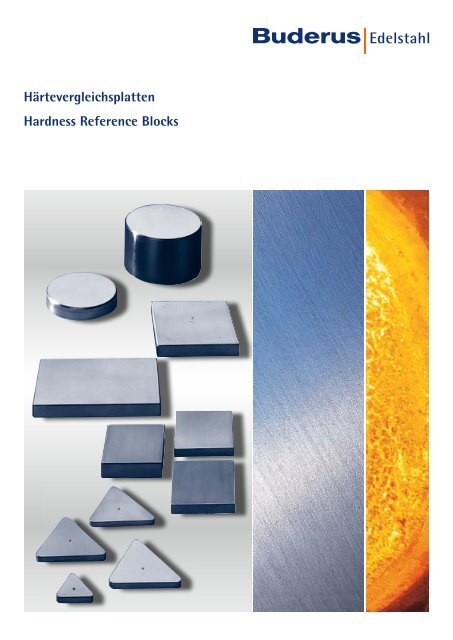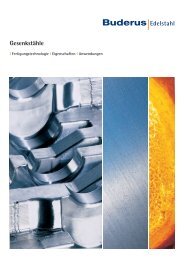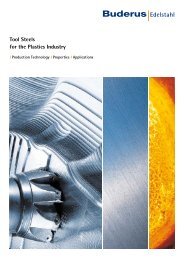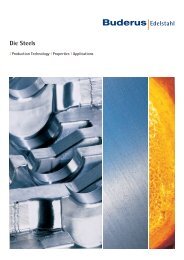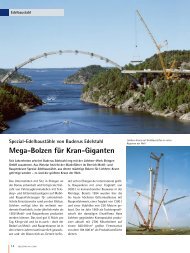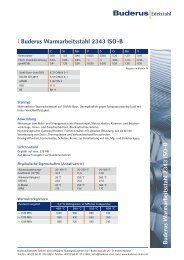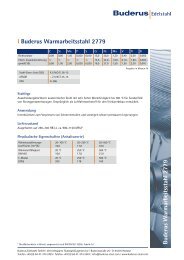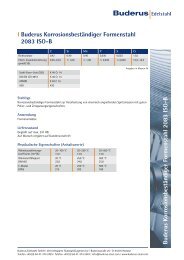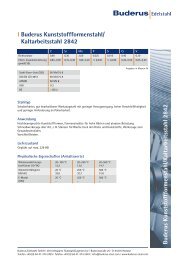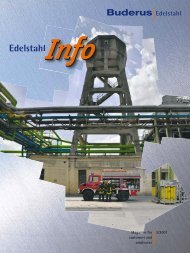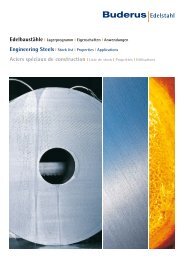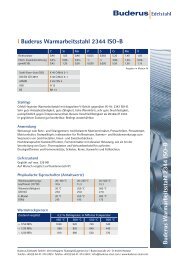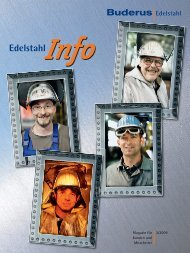Download - Buderus Edelstahl Gmbh
Download - Buderus Edelstahl Gmbh
Download - Buderus Edelstahl Gmbh
Erfolgreiche ePaper selbst erstellen
Machen Sie aus Ihren PDF Publikationen ein blätterbares Flipbook mit unserer einzigartigen Google optimierten e-Paper Software.
Härtevergleichsplatten<br />
Hardness Reference Blocks
Härtevergleichsplatten dienen der jährlichen indirekten Prüfung<br />
und Kalibrierung der Härteprüfmaschinen, der periodischen<br />
(täglichen) Prüfung der Prüfmaschine (siehe Seite 8)<br />
sowie einer Übertragung einer Härteskale auf eine Prüfmaschine.<br />
Sie sind damit ein unentbehrliches Hilfsmittel des betrieblichen<br />
Qualitätsmanagement. Nur durch den Einsatz von<br />
hochwertigen und präzisen Härtevergleichs platten, die nach<br />
den gültigen Normen mit minimaler Meßunsicherheit kalibriert<br />
werden, kann die Funktionsfähigkeit einer Härteprüfmaschine<br />
sichergestellt werden.<br />
Die Qualitätsanforderungen an die Härtevergleichs platten in<br />
Bezug auf die notwendige Homogenität, Ge fügestabilität, Gleichmäßigkeit<br />
der Härte, Oberflächenbeschaffenheit usw. sind in den<br />
entsprechenden internationalen, europäischen und nationalen<br />
Normen beschrieben und werden von den <strong>Buderus</strong>-Platten weit<br />
übertroffen. Die gesamte Herstellung erfolgt nach einer mit dem<br />
Materialprüfungsamt Nordrhein-Westfalen (MPA NRW) vereinbarten<br />
Qualtitätsricht linie, die gegenüber der Norm erheblich<br />
engere Werte vorschreibt. So sind beispielsweise bei der mechanischen<br />
Bearbeitung die Grenz werte der qualitätsrelevanten Formparameter<br />
Rauheit, Ebenheit und Planparallelität gegenüber der<br />
Norm halbiert. Dies erfordert eine äußerst aufwendige Fertigung,<br />
was bereits mit der Auswahl und Produktion des ent sprechenden<br />
Vormaterials beginnt und sich über komplizierte Wärmebehandlungsverfahren,<br />
sorgfältigste Bearbeitung, bis zur Kalibrierung<br />
beim MPA NRW fortsetzt.<br />
Grundsätzlich sollten die für die indirekte Prüfung eingesetzten<br />
Härtevergleichsplatten, im Härtebereich und elastisch, plastischen<br />
Verhalten mit dem zu prüfenden Werkstück weitgehend<br />
übereinstimmen. Aus diesem Grunde wurde auch für den unteren<br />
Härtebereich, der mit Stahl nicht mehr abzudecken ist, mit neuen<br />
Methoden der Werkstofftechnik eine den Normen entsprechende<br />
Härtevergleichsplatte aus Aluminium entwickelt.<br />
Der Bereich Kalibrierung von Härtevergleichsplatten des MPA<br />
NRW ist als DKD-Kalibrierlabor akkreditiert beim Deutschen Kalibrierdienst<br />
(DKD), der Unterzeichner des multilateralen Übereinkommens<br />
mit der European Cooperation for Accreditation (EA)<br />
zur gegenseitigen Anerkennung von Kalibrierscheinen ist. Daher<br />
genießen die kalibrierten <strong>Buderus</strong>-Härtevergleichsplatten nicht<br />
nur in Deutschland, sondern auch international uneingeschränkte<br />
Akzeptanz.<br />
Bei der Anwendung von Härtevergleichsplatten ist es un erheblich<br />
ob der Wert der lieferbaren Standardhärte mit dem tatsächlich<br />
ermittelten Kalibrierwert genau übereinstimmt, da die<br />
Skalenanpassung nach den gültigen Normen mit mindestens zwei<br />
Härtewerten erfolgt, von denen jeweils einer über und der andere<br />
unter dem Härtewert der Probe liegt.<br />
Eine Härtevergleichsplatte ist entsprechend den normativen<br />
Vorgaben nur für das Prüfverfahren<br />
und die Prüfbedingung verwendbar,<br />
für die sie kalibriert wurde.<br />
2<br />
<strong>Buderus</strong><br />
Härtevergleichsplatten<br />
<strong>Buderus</strong> Hardness<br />
Reference Blocks<br />
Hardness reference blocks are used for annual verification and<br />
calibration of hardness testing machines, the periodic (daily)<br />
check (see page 8) and sometimes for overtaking of hardness<br />
scales on a hardness testing machine. That’s why they are a<br />
necessary help of industrial Quality Management. Only the use<br />
of high quality, precise hardness reference blocks calibrated to<br />
applicable standards can ensure the functionality and relative<br />
reliability and accuracy of measurement of a hardness testing<br />
machine.<br />
The quality requirements for hardness reference blocks in respect<br />
of the necessary homogeneity, microstructure stability, uni formity<br />
of hardness, surface quality, are described in the corresponding<br />
international, european and national standards, and are easily<br />
exceeded by the <strong>Buderus</strong> blocks. The limits for the single parameters<br />
were much reduced within the internal guideline agreed<br />
upon with the materials testing institute of Nordrhein-Westfalen<br />
(MPA NRW). For the mechanical treatment for instance the parameters<br />
for roughness, flatness, and parallelism are reduced to<br />
half the values of the standards. This requires extremely sophisticated<br />
production, starting with the selection and production of<br />
suitable input stock, and including complicated heat treatment<br />
processes, extremely careful machining and calibration at the<br />
MPA NRW.<br />
The hardness reference blocks used for indirect verification<br />
should conform largely to the work piece to be tested, in terms of<br />
material characteristics and hardness range. For this reason a<br />
hardness reference block made of aluminium was developed for<br />
the lower hardness range which can not be covered by steel,<br />
using new materials technology methods.<br />
The division of MPA NRW responsible for calibration of hardness<br />
reference blocks has been accreditated as DKD-calibration<br />
Laboratory of Deutscher Kalibrierdienst (DKD) who is signatory of<br />
the multilateral agreement of the European Cooperation for Accreditation<br />
(EA) for mutual recognition of calibration certifcates.<br />
That ist one of the reasons why the calibrated hardness reference<br />
blocks distributed by <strong>Buderus</strong> are accepted without reservation<br />
not only in Germany but as well internationally.<br />
When using hardness reference blocks it is irrelevant whether<br />
the value of the nominal hardness to be delivered corresponds<br />
exactly to the actual calibration value observed, since scale adaptation<br />
should be carried out with at least two hardness values.<br />
A hardness reference block shall only be used as according to<br />
the standards to that method and test condition for which it was<br />
calibrated.<br />
Ebenheitsprüfung an Makro-Platten<br />
Flatness test on macro blocks
Rockwell<br />
Härtevergleichsplatten aus Stahl<br />
für das Rockwell-Prüfverfahren<br />
Bei der Härteprüfung metallischer Werkstoffe wird das Rockwell-<br />
Verfahren wegen der einfachen Handhabung und Auswertung<br />
sowie der Automatisierbarkeit am häufigsten angewandt. Die Ermittlung<br />
des Härtewertes erfolgt durch die Messung der bleibenden<br />
Eindringtiefe. Die verschiedenen Härteskalen unterscheiden<br />
sich hinsichtlich<br />
l Eindringkörper<br />
l Prüfvorkraft<br />
l Prüfgesamtkraft<br />
l Berechnung des Härtewertes.<br />
Als Eindringkörper werden je nach Prüfverfahren ein Diamantkegel<br />
bzw. eine Hartmetallkugel (W) oder eine Stahlkugel (S) verwendet.<br />
<strong>Buderus</strong> Rockwell Härtevergleichsplatten mit Kalibrierscheinen<br />
des Material-Prüfungsamtes Nordrhein-Westfalen (MPA-NRW)<br />
sind lieferbar für alle genormten Prüfverfahren.<br />
oder/or<br />
Plattengröße/Block size: 60 x 60 x 16 mm<br />
Plattengewicht ca./Block weight approx: 0,45 kg<br />
Plattengröße/Block size: 70 x 70 x 70 x 6 mm<br />
Plattengewicht ca./Block weight approx.: 0,13 kg<br />
Entsprechend der neuen Rockwell Norm wird jedoch die Quadratplatte<br />
wegen der größeren Dicke dringend empfohlen.<br />
Härteskala<br />
Hardness scale<br />
Standard-Härtewerte/Nominal hardness values<br />
Hardness Reference Blocks<br />
made of Steel for the Rockwell Test<br />
The method most commonly used for hardness testing of metal<br />
materials is the Rockwell hardness test, because of it’s simplicity<br />
of operation and evaluation, and capability for automation. The<br />
hardness value is determined by measuring the permanent depth<br />
of indentation. The various hardness scales differ in terms of<br />
l indenter<br />
l preliminary test force<br />
l total test force<br />
l calculation of the hardness value.<br />
Depending on the particular test condition, the indenter used is a<br />
diamond cone or a hard metal alloy ball (W) or a steel ball (S).<br />
<strong>Buderus</strong> Rockwell test blocks with a test certificate from MPA<br />
NRW are available for all standard test methods.<br />
Lichtinterferenzbild eines Rockwelleindrucks<br />
Interference picture of a Rockwell indentation<br />
According to the new Rockwell standard the use of a square block<br />
with a larger thickness however is highly recommended.<br />
HRA 40 49 55 59,8 62,4 65 67,6 70,2 72,8 75,4 78,1 80,7 82 83,4<br />
HRB (S/W) 60 75 90 100<br />
HRC 20 25 30 35 40 45 50 55 60 62/63 65<br />
HRF (S/W) 90 95 115<br />
HR15N 67,7 70,5 73,4 76,2 79,1 81,9 84,7 87,5 89,9 90,8 91,3<br />
HR30N 41,2 45,6 50,1 54,6 59,1 63,6 68 72,1 76,8 79 81,2<br />
HR45N 19,7 25,4 31,2 37 42,8 48,5 54,3 60 65,7 68,5 71,4<br />
HR15T (S/W) 80 86,5 91 92,2<br />
HR30T (S/W) 56,5 69,2 77,3 82<br />
HR45T (S/W) 33,5 52,8 64,6 72,1<br />
HRG (S/W) 62 81 87 94<br />
HRE (S/W) 95<br />
HRD 40 44 48 51 55 59 63 67 71 73 75<br />
HRK (S/W) 76 97<br />
HR62,5 58,2 61 63,7 66,4 69,2 72 74,7 77,5 80,2 81,6 83<br />
HB-T 2,5/187,5 (W) 25 53 61 65<br />
HB-T 2,5/62,5 (W) 72 80 85<br />
HB-T 2,5/31,25 (W) 45 65<br />
3
Härtevergleichsplatten aus Stahl<br />
für das Vickers-Prüfverfahren<br />
Das Verfahren für die Härteprüfung nach Vickers funktioniert<br />
ähnlich wie das Brinell-Verfahren, jedoch wird als Eindringkörper<br />
eine Diamantpyramide mit quadratischer Grundfläche verwendet.<br />
Zur Berechnung des Härtewertes dienen die Prüfkraft und die<br />
Länge der mittleren Diagonale des erzeugten Eindrucks.<br />
Je nach Prüfkraft unterscheidet man die lieferbaren Vickers-<br />
Prüfplatten in<br />
l Mikro-Platten (HV 0,005 bis HV 10)<br />
l Makro-Platten (HV 1 bis HV 150)<br />
4<br />
Vickers<br />
Polierte Oberfläche/Polished surface<br />
Plattengröße/Block size: 35 x 35 x 35 x 6 mm<br />
Plattengewicht ca./Block weight approx.: 0,035 kg<br />
Härteskala<br />
Hardness scale<br />
HV 0,001<br />
Standard-Härtewerte/Nominal hardness values<br />
HV 0,005 200 240<br />
HV 0,010 200 240<br />
HV 0,015 200 240 300 350 400 450 540<br />
HV 0,025 200 240 300 350 400 450 540 620 720<br />
HV 0,03 200 240 300 350 400 450 540 620 720<br />
HV 0,05 200 240 300 350 400 450 540 620 720 840<br />
HV 0,1 200 240 300 350 400 450 540 620 720 840<br />
HV 0,2 200 240 300 350 400 450 540 620 720 840<br />
HV 0,3 200 240 300 350 400 450 540 620 720 840<br />
HV 0,5 200 240 300 350 400 450 540 620 720 840<br />
HV 1 200 240 300 350 400 450 540 620 720 840<br />
HV 2 200 240 300 350 400 450 540 620 720 840<br />
HV 3 200 240 300 350 400 450 540 620 720 840<br />
HV 5 200 240 300 350 400 450 540 620 720 840<br />
HV 10 200 240 300 350 400 450 540 620 720 840<br />
Polierte Oberfläche/Polished surface<br />
Plattengröße/Block size: 70 x 70 x 70 x 6 mm<br />
Plattengewicht ca./Block weight approx.: 0,13 kg<br />
Härteskala<br />
Hardness scale<br />
Standard-Härtewerte/Nominal hardness values<br />
HV 1 140 200 240 300 350 400 450 540 620 720 840<br />
HV 2 140 200 240 300 350 400 450 540 620 720 840<br />
HV 3 140 200 240 300 350 400 450 540 620 720 840<br />
HV 5 140 200 240 300 350 400 450 540 620 720 840<br />
HV 10 140 200 240 300 350 400 450 540 620 720 840<br />
HV 20 140 200 240 300 350 400 450 540 620 720 840<br />
HV 30 140 200 240 300 350 400 450 540 620 720 840<br />
HV 50 140 200 240 300 350 400 450 540 620 720 840<br />
HV 60 140 200 240 300 350 400 450 540 620 720 840<br />
HV 100 140 200 240 300 350 400 450 540 620 720 840<br />
HV 120 140 200 240 300 350 400 450 540 620 720 840<br />
HV 125 140 200 240 300 350 400 450 540 620 720 840<br />
HV 150 140 200 240 300 350 400 450 540 620 720 840<br />
Hardness Reference Blocks<br />
made of Steel for the Vickers Test<br />
Vickers hardness test is comparable to that of Brinell, but<br />
the indenter used is a diamond pyramid with a square base. The<br />
hardness value is calculated using the test force and the length of<br />
the centre diagonal of the resultant impression.<br />
Depending on the test force, a distinction is made in the<br />
Vickers test plates available between<br />
l Micro blocks (HV 0.005 to HV 10)<br />
l Macro blocks (HV 1 to HV 150)<br />
Lichtinterferenzbild eines Vickers eindrucks<br />
Interference picture of a Vickers indentation<br />
Platten mit Härtewert 140 HV sind nur als<br />
Makro-Platten (Schenkellänge 70 mm) lieferbar.<br />
Eine Kalibrierung außerhalb des Anwendungsbereiches<br />
der Norm erfolgt in Anlehnung an die Norm.<br />
Blocks with hardness value 140 HV are only<br />
available as Macro Blocks (side length 70 mm).<br />
A calibration outside of the standard range is done<br />
by following the standard.<br />
Vickerseindruck im Hellfeld<br />
Vickers indentation in the bright field
Knoop<br />
Härtevergleichsplatten aus Stahl<br />
für das Knoop-Prüfverfahren<br />
Das Verfahren nach Knoop entspricht vom Prinzip her dem Vickers-Prüfverfahren.<br />
Als Eindringkörper dient eine Diamantpyramide<br />
mit rhombischer Grundfläche.<br />
Polierte Oberfläche/Polished surface<br />
Plattengröße/Block size: 35 x 35 x 35 x 6 mm<br />
Plattengewicht ca./Block weight approx.: 0,035 kg<br />
Härteskala<br />
Hardness scale<br />
Standard-Härtewerte/Nominal hardness values<br />
HK 0,005 140 200 240<br />
HK 0,01 140 200 240<br />
HK 0,015 140 200 240 300 350 400 450 540<br />
HK 0,025 140 200 240 300 350 400 450 540 620 720<br />
HK 0,05 140 200 240 300 350 400 450 540 620 720 840<br />
HK 0,1 140 200 240 300 350 400 450 540 620 720 840<br />
HK 0,2 140 200 240 300 350 400 450 540 620 720 840<br />
HK 0,3 140 200 240 300 350 400 450 540 620 720 840<br />
HK 0,5 140 200 240 300 350 400 450 540 620 720 840<br />
HK 1 140 200 240 300 350 400 450 540 620 720 840<br />
HK 2 140 200 240 300 350 400 450 540 620 720 840<br />
Brinell<br />
Härtevergleichsplatten aus Stahl<br />
für das Brinell-Prüfverfahren<br />
Bei dem Brinell-Prüfverfahren wird ein Eindringkörper (Kugel) in<br />
die Oberfläche einer Probe eingedrückt und der dabei entstandene<br />
Eindruckdurchmesser gemessen. Als Eindringkörper sind seit<br />
1999 nur noch die Hartmetallkugeln (HBW) zugelassen.<br />
<strong>Buderus</strong> Brinell-Prüfplatten werden, abhängig vom Kugeldurchmesser,<br />
in unterschiedlichen Größen und unterschiedlichen<br />
Oberflächenbeschaffenheiten gefertigt.<br />
Plattengröße/Block size: 100 x 100 x 16 mm bzw./resp. 150 x 100 x 16 mm*<br />
Plattengewicht ca./Block weight approx.: 1,26 kg bzw./resp. 1,88k g*<br />
* bei Standardhärte 150 HBW/* for nominal hardness 150 HBW<br />
Härteskala<br />
Hardness scale<br />
Standard-Härtewerte/Nominal hardness values<br />
HBW 5/125 150<br />
HBW 5/250 150 200<br />
HBW 5/750 150 200 250 300 350 400 450 500 600<br />
HBW 10/500 150<br />
HBW 10/1000 150 200<br />
HBW 10/3000 150 200 250 300 350 400 450 500 600<br />
Plattengröße/Block size: 70 x 70 x 70 x 6 mm<br />
Plattengewicht ca./Block weight approx.: 0,13 kg<br />
Härteskala<br />
Hardness scale<br />
Standard-Härtewerte/Nominal hardness values<br />
HBW 2,5/15,625 100<br />
HBW 2,5/31,25 100<br />
HBW 2,5/62,5 100 150 200<br />
HBW 2,5/187,5 100 150 200 250 300 350 400 450 500 600<br />
Polierte Oberfläche/Polished surface<br />
HBW 1/5 150<br />
HBW 1/10 150 240<br />
HBW 1/30 150 240 300 400 450 540 620<br />
Hardness Reference Blocks<br />
made of Steel for the Knoop Test<br />
The Knoop hardness test is similar to that of Vickers. The indenter<br />
used is a diamond pyramid with rhombic base.<br />
Knoop Härtevergleichsplatte<br />
Knoop hardness reference block<br />
Platten mit Härtewert 140 HK sind nur als<br />
Makro-Platten (Schen kellänge 70 mm) lieferbar.<br />
Blocks with hardness value 140 HK are only<br />
available as Macro Blocks (side length 70 mm)<br />
Hardness Reference Blocks<br />
made of Steel for the Brinell Test<br />
In the Brinell test an indenter (ball) is pressed into the surface of<br />
a sample, and the resultant diameter of the indentation is measured.<br />
Since 1999 only hardmetal alloy balls (HBW) are used as<br />
indenters.<br />
<strong>Buderus</strong> Brinell test blocks are produced in different sizes and<br />
different surface finishes depending on the ball diameter.<br />
Brinelleindruck im Dunkelfeld<br />
Brinell indentation in the dark field<br />
5
Härtevergleichsplatten aus Aluminium<br />
Seit Jahren besteht Bedarf an „weichen“ Platten. Mit Hilfe neuer<br />
Methoden der Werkstofftechnik ist es inzwischen möglich, normgerechte<br />
Härtevergleichsplatten aus Aluminium herzustellen. Lieferbar<br />
sind diese in den Standard-Härtewerten 60 HV30, 80 HV30<br />
und 100 HV 30 und je nach Prüfverfahren in zwei unterschiedlichen<br />
Plattengrößen.<br />
Härtevergleichsplatten aus Stahl<br />
für das Martenshärte Prüfverfahren<br />
Die Martenshärte HM ist ein genormtes Verfahren der registrierenden<br />
Härteprüfung mit der Möglichkeit der Bestimmung weiterer<br />
Werkstoffkennwerte. Der Prüfvorgang erfolgt kraft- oder<br />
eindringtiefengesteuert mit einem Eindringkörper, der in den<br />
meisten Fällen ein Vickersdiamant ist. Anwendung findet dieses<br />
Verfahren insbesondere bei der Härteprüfung von dünnen, harten<br />
Schichten und Lacken.<br />
6<br />
Aluminium<br />
Rockwell<br />
Plattengröße/Block size: 75 x 75 x 16 mm<br />
Plattengewicht ca./Block weight approx.: 0,195 kg<br />
Härteskala<br />
Hardness scale<br />
Standard-Härtewerte<br />
Nominal hardness values<br />
HRB (S/W) 37 60<br />
HRE (S/W) 67 85 92<br />
HRF (S/W) 66 84 90<br />
HRH (S/W) 93<br />
HRK (S/W) 36 61 72<br />
HR15T (S/W) 66 76 80<br />
HR30T (S/W) 27 48 56<br />
HR45T (S/W) 20 34<br />
Brinell<br />
Plattengröße/Block size: 150 x 100 x 16 mm<br />
Plattengewicht ca./Block weight approx.: 0,52 kg<br />
Härteskala<br />
Hardness scale<br />
Standard-Härtewerte<br />
Nominal hardness values<br />
HBW 5/62,5 60 80<br />
HBW 5/125 60 80 100<br />
HBW 5/250 60 80 100<br />
HBW 10/250 60 80<br />
HBW 10/500 60 80 100<br />
HBW 10/1000 60 80 100<br />
Martenshärte/Martens Hardness<br />
Polierte Oberfläche/Polished surface<br />
Plattengröße/Block size: 35 x 35 x 35 x 6 mm<br />
Plattengewicht ca./Block weight approx.: 0,035 kg<br />
Hardness Reference Blocks made of Aluminium<br />
For several years there has been a need for “soft” blocks. Using<br />
new materials technology methods, it is now possible to produce<br />
hardness reference blocks made of aluminium. They are available<br />
in the nominal hardness values 60 HV30,80 HV30 and 100 HV 30<br />
in two different block sizes depending on the test.<br />
Vickers<br />
Polierte Oberfläche/Polished surface<br />
Plattengröße/Block size: 75 x 75 x 16 mm<br />
Plattengewicht ca./Block weight approx.: 0,195 kg<br />
Härteskala<br />
Hardness scale<br />
Standard-Härtewerte<br />
Nominal hardness values<br />
HV 1 60 80 100<br />
HV 2 60 80 100<br />
HV 3 60 80 100<br />
HV 5 60 80 100<br />
HV 10 60 80 100<br />
HV 20 60 80 100<br />
HV 30 60 80 100<br />
HV 50 60 80 100<br />
HV 60 60 80 100<br />
Brinell<br />
Plattengröße/Block size: 75 x 75 x 16 mm<br />
Plattengewicht ca./Block weight approx.: 0,195 kg<br />
Härteskala<br />
Hardness scale<br />
Standard-Härtewerte<br />
Nominal hardness values<br />
HBW 2,5/15,625 60 80<br />
HBW 2,5/31,25 60 80 100<br />
HBW 2,5/62,5 60 80 100<br />
Hardness Reference Blocks made of Steel<br />
for the Martens Hardness Test<br />
The hardness testing method Martens HM is a registrating<br />
method, which incorporates the possibility for the determination<br />
of further materials parameters according to existing standards.<br />
The test is carried out force or indentation depth controlled with<br />
an indenter, which is in most cases a diamond according to Vickers.<br />
The method is especially used for thin hard layers and coatings.<br />
Standard-Härtewerte Vickers Mikro/Martenshärte HM 0,05 bis HM 1<br />
Nominal hardness values Vickers Micro/Martens-hardness HM 0,05 to HM 1<br />
240 HV 2500 N/mm2 540 HV 5000 N/mm2<br />
300 HV 3000 N/mm2 620 HV 5600 N/mm2<br />
400 HV 4000 N/mm2 720 HV 6200 N/mm2<br />
450 HV 4400 N/mm2 840 HV 7000 N/mm2
Leebhärte/Leeb Hardness<br />
Härtevergleichsplatten aus Stahl<br />
für die dynamische Rückprall-Härteprüfung<br />
Mit der mobilen Härteprüfung wird eine schnelle Prüfung vor Ort<br />
am Bauteil ermöglicht. Ein inzwischen weit verbreitetes und genormtes<br />
Verfahren hierfür ist die Rückprall-Härteprüfung (Verfahren<br />
nach Leeb), wobei die Härte des Werkstoffes indirekt über<br />
den Geschwindigkeitsverlust eines Schlagkörpers beim Aufprall<br />
auf das Prüfmaterial gemessen wird (HLD-/HLG-Wert).<br />
Die Messwerte werden meistens in die gewohnten Härteskalen<br />
(Rockwell, Brinell, Vickers) umgewertet. Aufgrund der dynamischen<br />
Kraftaufbringung ist eine entsprechende Masse und Dicke<br />
der Härtevergleichsplatte erforderlich, um ein unerwünschtes<br />
Nachgeben oder Springen und damit eine Verfälschung der Prüfergebnisse<br />
zu verhindern. Verschiedene Schlaggeräte erfordern<br />
daher unterschiedliche Plattengrößen.<br />
Polierte Oberflächen/Polished surfaces<br />
Plattengröße/Block size: Rd. 90 x 56 mm<br />
Plattengewicht ca./Block weight approx.: 2,79 kg<br />
Härteskala<br />
Hardness scale<br />
Standard-Härtewerte<br />
Nominal hardness values<br />
HLD 470 660 780<br />
(HRC) (20) (45) (60)<br />
Härteskala<br />
Hardness scale<br />
Polierte Oberflächen/Polished surfaces<br />
Plattengröße/Block size: Rd. 120 x 70 mm<br />
Plattengewicht ca./Block weight approx.: 6,2 kg<br />
Standard-Härtewerte<br />
Nominal hardness values<br />
HLG 480 570 670<br />
(HRC) (20) (37) (52)<br />
<strong>Buderus</strong>-Härtevergleichsplatten werden mit einem amtlichen<br />
Kalibrierschein (DKD) des Materialprüfungsamtes Nordrhein-<br />
Westfalen (MPA NRW) geliefert. Der Verkauf an Endverbraucher<br />
erfolgt nur durch Hersteller und Vertreiber von Härteprüfmaschinen<br />
und Servicebetriebe.<br />
Auf jeder Platte werden der bei der Kalibrierung ermittelte<br />
Härtewert, die Härteskala, eine Registriernummer sowie der<br />
Monat und das Jahr der Kalibrierung eingraviert.<br />
Die Prüffläche jeder Platte ist mit einem „B“ als Herstellerkennzeichen<br />
und zusätzlich bei Vickers-, Knoop- und Brinell-Platten mit<br />
einem durch einen Kreis markierten Kontrolleindruck versehen. Auf<br />
Wunsch kann ferner auf Brinell-Platten (Quadrat/Rechteck) und<br />
Rockwell-Platten (Quadrat) ein Raster aufgebracht werden.<br />
Für Rückfragen und zusätzliche Informationen stehen Ihnen<br />
die zuständigen Mitarbeiter von <strong>Buderus</strong> <strong>Edelstahl</strong> und des Materialprüfungsamtes<br />
Nordrhein-Westfalen jederzeit gerne zur Verfügung.<br />
Sonderplatten, Platten mit Werkszertifikat sowie unkalibrierte<br />
Platten auf Anfrage.<br />
Hardness Reference Blocks made out of Steel<br />
for the Rebound Test<br />
With the mobile hardness test a quick in situ measuring of a component<br />
is possible. A meanwhile wide spread and standardized<br />
method is the rebound hardness (leeb method), whereby the<br />
hardness of the material is tested indirectly via speed loss of the<br />
impact body when clashing on the component to be tested (HLD/<br />
HLG value).<br />
Usually the measured hardness values are transfered into the<br />
more common hardness scales like Rockwell, Brinell or Vickers.<br />
Due to the dynamic power impact a hardness reference block is<br />
demanded which has an adequate mass and thickness in order to<br />
avoid an unwelcome yielding or bounding that leads to wrong<br />
test results. Different impact instruments therefore require hardness<br />
reference blocks with different sizes.<br />
Leeb Härtevergleichsplatte<br />
Leeb hardness reference block<br />
Zusätzliche Informationen/Additional Informations<br />
<strong>Buderus</strong> hardness reference blocks are supplied with an official<br />
calibration certificate (DKD) of the materials testing institute of<br />
Nord rhein-Westfalen (MPA NRW). The distribution to the end<br />
consumers is done only by the producers and distributors of hardness<br />
testing machines and service centres.<br />
The hardness determined on calibration, the hardness scale, a<br />
registration number and the month and year of calibration are<br />
engraved on each block.<br />
The test surface of each block is supplied with a ”B“ as the<br />
manufacturers’ mark and additionally with a monitoring indentation<br />
marked with a circle for Vickers, Knoop and Brinell blocks. On<br />
request a screen on Brinell blocks (square/rectangular) and Rockwell<br />
blocks (square) can also be applied.<br />
The employees responsible at <strong>Buderus</strong> <strong>Edelstahl</strong> and at the materials<br />
testing institute of Nordrhein-Westfalen will be pleased to<br />
respond to any enquiries and provide additional information at<br />
any time.<br />
Special blocks, blocks with mill certificate and uncalibrated<br />
blocks on request.<br />
7
Qualitätssicherung<br />
bei der Härteprüfung<br />
Für die Qualitätssicherung empfehlen die seit 1999 veröffentlichten<br />
Normen, als Ergänzung der jährlichen Prüfung, eine Prüfung<br />
der Härteprüfmaschine an jedem Tag, an dem diese benutzt wird.<br />
Zur Dokumentation, Berechnung und Darstellung der Qualitätssicherung<br />
wird zu jeder von <strong>Buderus</strong> vertriebenen Härtevergleichsplatte<br />
ein EXCEL-Programm erstellt, in dem u. a. der Kalibrierwert,<br />
die Grenzabweichung und die tolerierbare Wiederholpräzision der<br />
Härteprüfmaschine sowie die Messunsicherheit der jeweiligen<br />
Platte erfasst sind. Das Programm wird einschließlich weiterer Informationen<br />
bereitgehalten unter der Internet Adresse (URL)<br />
http://www.mpanrw.de/crm. Nach Eingabe der MPA NRW Nummer<br />
und des Härtewertes einer Härtevergleichsplatte kann das<br />
<strong>Download</strong> durch anklicken des OK-Feldes gestartet werden. Eine<br />
Testversion ist erhältlich durch die Eingabe von „demo“ an den<br />
beiden genannten Stellen. Bei Anwendung des Programmes wird<br />
für Härteprüfmaschinen mittels Härtevergleichsplatte deren<br />
Messunsicherheit und nach Norm die Wiederholpräzision und Abweichung<br />
berechnet. Mit dem Programm wird kontrolliert und als<br />
Text angezeigt, ob die in den Normen vorgegebenen Werte durch<br />
die Maschine erreicht werden oder nicht.<br />
Bei der Bestimmung der Messunsicherheit bietet das Programm<br />
zwei Möglichkeiten der Berechnung<br />
l eine ohne Korrektur der Abweichung entsprechend des UNCERT<br />
SMT Reportes der EU und<br />
l eine mit Korrektur der Abweichung vom Sollwert.<br />
Differenzhärte<br />
Deviation of hardness<br />
2,00<br />
1,50<br />
1,00<br />
0,50<br />
0,00<br />
–0,50<br />
–1,00<br />
–1,50<br />
–2,00<br />
Kalibrierung<br />
23. 8. 2000<br />
25. 8. 2000<br />
29. 8. 2000<br />
31. 8. 2000<br />
2. 9. 1999<br />
5. 9. 1999<br />
7. 9. 1999<br />
8. 9. 1999<br />
12. 9. 1999<br />
Datum/Date<br />
Abweichung vom Mittelwert<br />
Deviation from mean value<br />
Rechtshinweis: Die <strong>Buderus</strong> <strong>Edelstahl</strong> GmbH hat die vorliegenden Informationen mit größtmöglicher Sorgfalt<br />
zusammengestellt. Trotz aller Sorgfalt können sich Daten in der Zwischenzeit verändert haben. Die <strong>Buderus</strong><br />
<strong>Edelstahl</strong> GmbH schließt jede Haftung oder Gewähr hinsichtlich der Genauigkeit, Aktualität, Richtigkeit und<br />
Vollständigkeit der zur Verfügung gestellten Informationen aus. Bei gemachten Angaben handelt es sich<br />
lediglich um Beschreibungen und Anhaltswerte, welche nur dann verbindlich sind, wenn sie als Zusagen in<br />
einem mit <strong>Buderus</strong> <strong>Edelstahl</strong> GmbH abgeschlossenen Vertrag ausdrücklich vereinbart werden. Des Weiteren<br />
behält sich die <strong>Buderus</strong> <strong>Edelstahl</strong> GmbH das Recht vor, jederzeit ohne Voranmeldung Änderungen vorzunehmen.<br />
Die <strong>Buderus</strong> <strong>Edelstahl</strong> GmbH weist jegliche Haftung für Schäden jeglicher Art, einschließlich Folgeschäden,<br />
die im Zusammenhang mit der Verwendung der bereitgestellten Informationen entstehen, zurück.<br />
Ältere Veröffentlichungen verlieren ihre Gültigkeit. © <strong>Buderus</strong> <strong>Edelstahl</strong> GmbH, Wetzlar, 07/2010<br />
Materialprüfungsamt Nordrhein-Westfalen<br />
Marsbruchstraße 186<br />
D-44287 Dortmund<br />
Tel.: +49-231-4502440<br />
Fax: +49-231-4502666<br />
E-Mail: schwenk@mpanrw.de<br />
www.mpanrw.de<br />
Quality Insurances<br />
for Hardness Testing<br />
For the quality insurance the standards published since 1999 recommend,<br />
as addition to annual calibration and verification, a<br />
daily check of the hardness testing machines. For documentation,<br />
calculation and presentation of the quality insurance for all hardness<br />
reference blocks distributed by <strong>Buderus</strong> an EXCEL-program<br />
has been created, in which e.g. the calibration values, the allowed<br />
values for the error and the repeatability of the hardness testing<br />
machine and the uncertainty of the reference block are integrated.<br />
This program and further information may be overtaken<br />
by download from URL: http://www.mpanrw.de/crm. When inserting<br />
the MPA NRW number and the hardness value of the reference<br />
block, the download can be started by a click on OK. When<br />
inserting “demo” on both positions a test version of one block as<br />
an example is downloaded. When using a hardness reference<br />
block together with the program for hardness testing machines<br />
the uncertainty of measurement and – according to the standard<br />
– the repeatability and the error are determined. In the program<br />
is controlled and displayed as text whether the values of the<br />
machine are according to the standard or not.<br />
For the determination of uncertainty the program offers two<br />
possibilities<br />
l one without the correction of the error according to UNCERT<br />
proposal of SMT of EU and<br />
l one including the correction of error from nominal value.<br />
Wiederholpräzision<br />
Repeatability<br />
1,00<br />
0,90<br />
0,80<br />
0,70<br />
0,60<br />
0,50<br />
0,40<br />
0,30<br />
0,20<br />
0,10<br />
0,00<br />
Kalibrierung<br />
23. 8. 2000<br />
25. 8. 2000<br />
29. 8. 2000<br />
31. 8. 2000<br />
2. 9. 1999<br />
5. 9. 1999<br />
7. 9. 1999<br />
8. 9. 1999<br />
12. 9. 1999<br />
Datum/Date<br />
Legal notice: <strong>Buderus</strong> <strong>Edelstahl</strong> GmbH has taken the greatest care in compiling the information in this<br />
leaflet. It is nevertheless possible that data may have changed in the meantime. <strong>Buderus</strong> <strong>Edelstahl</strong> GmbH<br />
disclaims all liability or warranty as regards the accuracy, currency, correctness and completeness of<br />
the information provided, and any consequences arising from the use of the information. The information<br />
provided is merely indicative, and is binding only if it is expressly made a condition in a contract concluded<br />
with <strong>Buderus</strong> <strong>Edelstahl</strong> GmbH. <strong>Buderus</strong> <strong>Edelstahl</strong> GmbH moreover reserves the right to make changes at<br />
any time without notice. <strong>Buderus</strong> <strong>Edelstahl</strong> GmbH repudiates all liability for loss of any kind, including<br />
consequential loss, arising in connection with use of the information provided.<br />
© <strong>Buderus</strong> <strong>Edelstahl</strong> GmbH, Wetzlar, 11 / 2010<br />
<strong>Buderus</strong> <strong>Edelstahl</strong> GmbH<br />
<strong>Buderus</strong>straße 25<br />
D-35576 Wetzlar<br />
Tel.: +49 (0) 64 41 / 374 - 2410<br />
Fax: +49 (0) 64 41 / 374 - 2344<br />
E-Mail: info@buderus-steel.com<br />
www.buderus-steel.com<br />
04/11/AW/S/F


